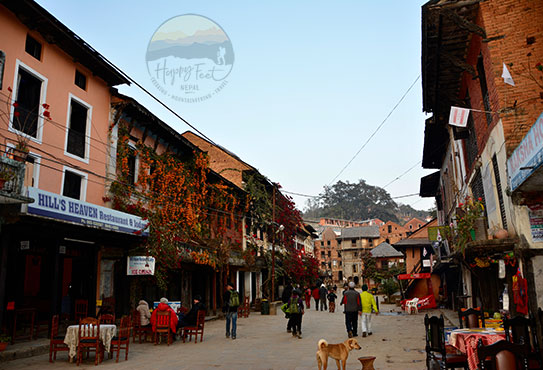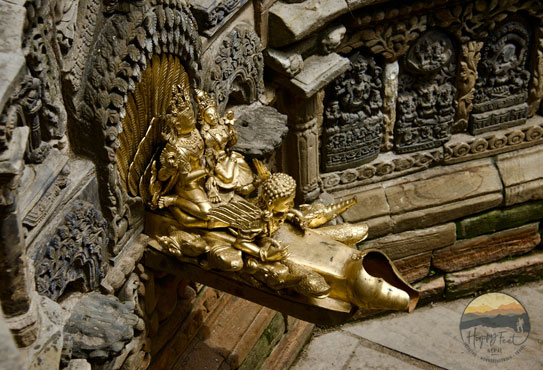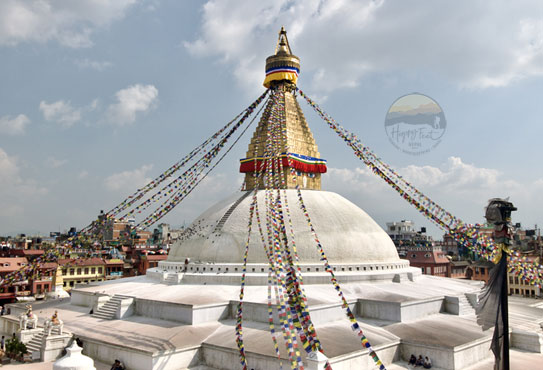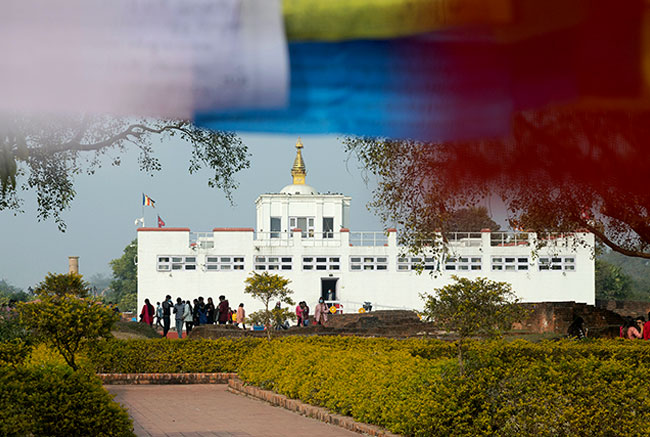Sunday - Friday: 9 AM - 4 PM
The Himalayas and Histories Tour
Himalayas and Histories Tour includes Kathmandu Valley, Gorkha, Bandipur, Pokhara and a panoramic flight to Mount Everest. Visiting seven World Heritage Sites
Tour Cost 1450$ Per Person!
Tour profile:
Guided Tour of Nepal, visiting seven World Heritage Sites by UNESCO in Kathmandu Valley. Visit the wish-fulfilling Hindu Temple of Manakamana. Visit the Gorkha Durbar, where current Nepal’s unification began. Visit Bandipur, a medieval trading post created by Newars. Admire Pokhara’s snow-capped mountains, green hills, valleys, rivers, beautiful lakes, and deep gorges. Fly over Mount Everest, the tallest mountain on the globe.
Arrive in Kathmandu, customs and immigration formalities and claim your baggage, which takes some time. Upon exiting, the arrivals get a traditional welcome from the Happy Feet Nepal representative and transfer to the hotel. Reach the hotel and the rest of the day is free with the possibility of optional excursions (not included), but you can ask to organise any of the tours or stroll through its vibrant streets.
Kathmandu, the capital and heart of the country with three medieval cities, symbolises Nepal’s everything. Having lived through the several ruling dynasties of Buddhists and Hindus, the culture and society of Kathmandu Valley have evolved through time to give it more than a unique feature. Today it is an urban city, and still rapidly increasing, that has its ancient myths and, at the same time, is testimony to the greatness of people who have lived there for time immemorial.
Accommodation in Hotel Shanker, a 4-star hotel.
Breakfast at the hotel and drive to Pashupatinath Temple. A pagoda temple with gilt roofs, carved with silver doors dedicated to Lord Shiva, situated at the bank of the holy Bagmati River, and regarded as among the most sacred temples of the Hindu religion, Pashupatinath is the focus of pilgrimages culminating in the day of Shiva Ratri (the marriage anniversary of Lord Shiva and the goddess Parvati). Pashupati is also the cremation ground in the ghats (cremation group) along the bank of River Bagmati, where the recently deceased Hindus of the Valley are cremated.
Then we take a 13-kilometres drive to Bhaktapur, east of Kathmandu. Its original name is, Bhadgaon, or the village of Devotees is one of the living museums of Kathmandu Valley. Bhaktapur is filled with the 55-windowed Royal Palace, the Palace of the Kumari, the temple of Taleju, the temple of Pashupati, the main square of Taumadhi Tole, Nyatapola Temple (the most imposing the tallest such architecture in all of Nepal), the temple of Akash Bhairab (the second most important temple of Bhadgaon), the Dha Hateya and the Square of the Potters. UNESCO recognises Bhaktapur as a World Heritage Site.
After the visit, we leave by road toward Nagarkot, at an altitude of 2,100m and 32 kilometres east of Kathmandu or 19 kilometres northeast of Bhaktapur. Nagarkot is one of the most beautiful hill resort areas to enjoy sunrises and Mountain Range views, from the Langtang to Everest.
Accommodation at the Club Himalaya, a 4-star hotel, breakfast included.
140 km – 4hrs drive.
Sunrise view tour. Breakfast at the hotel and departure by road to Gorkha, located 138 kilometres west of Kathmandu (169 km from Nagarkot), takes about a 5-hour sightseeing drive. On the way to Gorkha, visit a Hindu temple called Manakamana Mandir (Manakamana Temple). We will stop our car and take a cable car that arrives directly at the temple’s gate.
The visit and the return to the car take at least 2 hours. The Manakamana temple is 12-kilometers south of the historic town of Gorkha on a prominent hill, at an altitude of 1,310 meters above sea level, overlooking the river valleys of Trisuli (south) and Marsyangdi (west). Hindu devotees gather at this temple worldwide, believing that the Devi (goddess) Manakamana (mental wish), a wish-fulfilling goddess, fulfils the devotees’ wishes, thus called the wish-fulfilling deity. Visit the temple, return to the car, and drive to the River Spring Resort for the lunch stop. After lunch, drive to Gorkha.
Gorkha was the ancestral birthplace and residence of Shah kings for eight generations, until the ninth – Prithvi Narayan Sha, who successfully conquered the Kathmandu valley, unifying the current kingdom of Nepal. Gorkhas also gave his name to the fearsome soldiers who fought under King Prithvi Narayan Shah. The so-called “Gorkhas” would become a legend and later be recruited from all over the country, not just in Gorkha. The Gorkhas also served in the British and Indian armies, reconfirming their reputation as brave and tough men. The Gorkhas also intervened in the two world wars and many other global conflicts and always lived up to their reputation. The most famous of the last episodes was during the Falklands War between Argentina and the United Kingdom. Arrive at Gorkha and check into the hotel. In the evening, stroll the local bazaar, have dinner and overnight.
Accommodation at the Gorkha Inn, breakfast included.
Have breakfast and walk up to the castle of the “Father of the Nation” or Gorkha Durbar, from where King PrithiviNayaran Shah began his campaign for the unification of current Nepal, which once extended till Kolkata of present India and near Kashmir. The fort-like royal palace, called Gorkha Durbar, lies high above a hilltop like an eagle’s nest above the town in an invincible defensive position – with excellent views of valleys that stretch many meters below and the impressive Himalayas.
Visit the palace, walk to the hotel, and drive 55 kilometres to Bandipur. Bandipur lies at 1030 metres and 143 kilometres west of Kathmandu, and 74-kilometres southeast of Pokhara, and 7 kilometres south of Dumre Bazar. Bandipur, a hilltop settlement of a Newari community, lives still with its age-old custom and tradition and invites travellers to experience its rich hilly culture, mountain views, and side village hiking.
Accommodation in Old Inn or similar, a 4-star hotel. Breakfast included.
Early morning hike for stunning sunrise views from Tundikhel and Gurungche Hill to see beautiful views of the Himalayas. We then return to the hotel for breakfast. Then we visit the silkworm Farm and Cow and Agriculture Farms and return to the hotel for late lunch. In the afternoon, we take a short 70-kilometre thrilling drive to Pokhara.
Pokhara is one of the most attractive cities in Nepal. Touring this city lets you experience the incredible scenery, a unique combination of snow-capped mountains, green hills, valleys, rivers, beautiful lakes, deep gorges etc. Moreover, the weather in Pokhara is so lovely that you can enjoy your time to the fullest.
Accommodation in Temple Tree, a 4-star hotel. Breakfast included.
Breakfast at the hotel and transfer 13-kilometres to Pumdikot, a strategic hill with an ancient fort in ruins and recently converted into a Shiva temple; it is a beautiful viewpoint. The views of Annapurna, Pokhara and the peace stupa are beyond description. From Pumdikot, we take a scenic drive to Peace Stupa, enjoying magnificent views of Phewa Lake, the Himalayas, Pokhara City and its surroundings. The Peace Stupa site is equally beautiful, with splendid views.
The World Peace Stupa stands gloriously on a hill saddle above Phewa Lake and Pokhara City from where you get panoramic views of Phewa Lake, the city of Pokhara and Mount Annapurna and Lamjung (on a clear day). A Peace Stupa is a Buddhist monument to inspire peace in all races and creeds and to help unite them in their quest for world peace. Most of them were built since World War II under the direction of Nichidatsu Fujii (1885-1985), a Buddhist monk from Japan and founder of the Nipponzan-Myohoji Buddhist Order. In 1947, he started the construction of peace pagodas as world peace shrines, and in the year 2000, there were eighty Peace Pagodas built around the world between Europe, Asia and the United States.
Enjoy the landscapes of the site, visit the stupa, explore, go down to the lake shore, cross the lake by little boat, have a late lunch and visit the International Mountain Museum in Pokhara, where we will see and better understand the history of the mountain and mountaineering on the highest peaks in the world. We will understand the importance of the Himalayas of Nepal and the benefits that the Himalayas give to the millions of people and their natural habitat. After the visit, return to the shore of the lake for free time.
Accommodation in Hotel Temple Tree, a 4-star hotel, breakfast included.
Today visit David’s Fall, Gufteswor cave, and the Tibetan refugee camp. Then, for rest and lunch, go to the Fishtail Lodge at the dam site in a beautiful atmosphere. After lunch, visit the Seti Gorge and Old Pokhara. Then, the evening is back to the hotel and around Phewa Lake for a lovely evening walk while selecting a restaurant for dinner.
Accommodation in Hotel Temple Tree, a 4-star hotel breakfast included.
Early in the dawn, sunrise view tour to Sarangkot viewpoint. Sarangkot, the most famous lookout in Pokhara, offers a grand panorama of the Annapurna ranges, Machhapuchare, Manaslu, Lamjung Himal, and Dhaulagiri range. From the Sarangkot lookout, you can also see the beautiful view of Pokhara Valley and its unique landscapes with Lake Phewa, Lake Begnas and Lake Rupa. A short 25-minute drive from the hotel in Pokhara lakeside puts you on Sarangkot, which offers a striking view of sunrise and a platform for Paragliding. Finalise the tour and drive back to the hotel for breakfast.
After breakfast, drive to the airport for a 30-minutes flight to Kathmandu. Get landed at Kathmandu airport and greeted by the Happy Feet Mountaineers representative, and drive to your hotel in Thamel, which may take 20 to 40 minutes, depending on the traffic. The rest of the afternoon is free.
Accommodation in Hotel Shanker, a 4-star hotel, breakfast included.
Early in the morning, take a scenic mountain flight to enjoy the views and panorama of a 360-degree wide range of Himalayan peaks from Manaslu, Ganesh, Langtang, and Jugal Himal, Pumori, Lhotse, Nuptse, Mt. Everest and as far towards Mt. Makalu and Kanchenjunga towards far east. Most mountain flights operate early morning, from 6:30 a.m. to 9 a.m., with window seats and last for an hour. You can observe a mighty chain of Himalayan peaks both ways on the flight, never missing the core and highlight of mountain flight. Get landed at the airport and greeted and escorted back to the hotel for breakfast.
After breakfast, visit Swayambhunath, dating back more than 25 centuries, and one of the world’s oldest Buddhist chaityas, the great stupa of Swayambhunath is a landmark wonder of Nepal listed as a World Heritage Site. The all-seeing eyes of Lord Buddha keep an eternal watch over the valley.
Swayambhu is located west of Kathmandu proper on a hillock rising about 500 feet above the valley floor. The whole hill is a mosaic of small chaityas and pagodas—one Hinayana (Theravada) and five Mahayana (Vajrayana)—temples. The site offers a complete view of Kathmandu Valley, its surroundings, and the northeastern Himalayas.
In continuity, drive to Patan, one of the three medieval cities of Kathmandu Valley and one of the World Heritage sites among the seven World Heritage sites of Kathmandu Valley, located 7-kilometres southwest of Kathmandu. The city known as Lalitpur, the City of Arts, was a renowned Buddhist centre in Asia and has four Ashok-built Stupas and a multitude of miniature stupas, monasteries, viharas and temples. At Patan, we visit its Durbar Square, the Golden Temple, Thousand Buddha, and its museum, among other sites, which explain Buddhism and Hinduism in extensive labels within the living traditions and context.
The architecture represents some of the greatest achievements of the medieval Malla era. The stroll leads around the square past a host of pagoda temples (including the grand temple of the goddess Taleju) and a window framing Shiva and Parbati sitting together viewing the scene.
The square is full of colourful life centred on the Kasthamandap rest-house. Said to have been built with wood from a single tree (and the origin of Kathmandu’s name), it is now reconstructed in the wake of the 2015 earthquake. Then visit the Temple of Kumari; the residential quarters of the Living Goddess called Kumari (‘chaste virgin’) consists of a traditional building complex featuring carved wooden balconies and windows.
Also impossible to overlook are the great bell and large drums. The palace’s main golden gate is guarded by the monkey god Hanuman, the faithful devotee of Lord Ramachandra, the hero of the epic Ramayana.
Finally, pass through the Hanuman Dhoka: the historic seat of the past Malla and Shah dynasties. The historic temples and palaces epitomise the religious and cultural lifestyle of the rulers. Among the most interesting things to view is the Taleju Temple, built by King Mahindra Malla in A.D. 1549 and a historical museum containing artefacts of past Shah kings.
We finalise with the tour and ride a rickshaw and roll through its old city market centre, the Ason Bazaar, seeing what the Nepalese people buy and sell in their daily run.
Accommodation in Hotel Shanker, a 4-star hotel, breakfast included.
Breakfast and the rest of the day are leisure on your own. The Representative of Happy Feet Nepal will arrive at your hotel with transport three hours before your departure flight time. Get escorted from the hotel to the International Departure Terminal, see off formalities, and go through the immigration and departure.
Breakfast included.
Sarankot Hill
Sarangkot, the most famous lookout in Pokhara, offers a grand panorama of the Annapurna ranges, Machhapuchare, Manaslu, Lamjung Himal, and Dhaulagiri range. From the Sarangkot lookout, you can also see the beautiful view of Pokhara Valley and its unique landscapes with Lake Phewa, Lake Begnas and Lake Rupa. A short 25-minute drive from the hotel in Pokhara lakeside puts you on Sarangkot, which offers a striking view of sunrise and a platform for Paragliding.
Phewa Lake
Phewa Lake is the largest lake in Pokhara, which attracts many visitors and offers water activities and is a natural jewel to the city. If you take boating on the lake, you can enjoy the reflection of the fishtail and Annapurna Mountains all day and a beautiful sunset colour in the evening. A small island
The Island is in the lake’s centre and has a two-storied pagoda temple dedicated to the Ajima, the protector deity in Buddhist and Hindu, representing female Shakti (power). The southwestern shorelines are densely protected jungles known as Rani Ban (Queen Forest), a lovely sanctuary for birdlife. Other major lakes in Pokhara are Begnas Tal and Rupa Tal, situated to the northeast of the city, within an hour’s driving distance.
Seti Gorge
Seti Gorge is offered as a site to see in Pokhara. Seti Gorge is the section cut by the river Seti to a deep underground; at places hides the entire river and, in some areas, two meters in width and 20 to 50 metres in depth. There are two sites to see the depth of Seti Gorge; one just from the centre of the local bazaar at Mahendra Pul (bridge) and another just a little further at KI Sing Pul (bridge) with a park and garden. The parts are wild and fragile, and strictly suggested not to try to see them.
David’s Fall
Another attraction of Pokhara is the beautiful cascading waterfalls popularly known as Devi’s Fall, locally called Patale Chhango, another attraction of Pokhara, two kilometres southwest of the city. David’s Fall is named after a person with the same name who fell underground in the water. The site is attractive in the summertime when the tremendous amount of water from Phewa Lake falls underground,
Caves of Pokhara
There are two main caves for exploring. First, the Mahindra Gufa (cave), locally known as Bats Cave, is 45 minute drive north of Pokhara. A (torch/flashlights recommended while visiting caves) enter for some time and view the large limestone, stalactites and stalagmites, and the bats.
Another cave is Gufteswor Gufa, just walking distance from Devis’ Fall across the street. The entrance is wide with artificial steps and a later-built Shiva shrine. One can go further down to view the raging Seti River entering a channel into the cave.
The Old Bazaar
The old city of Pokhara is a beautiful site to visit. The houses and temples in this part of the city reflect the Newari architecture of Kathmandu Valley, as some Newari communities from Kathmandu moved to Pokhara for trading. The local bazaar has Bindhayabasini Mandir (temple); this white dome-shaped temple dominates a spacious stone-paved courtyard on a shady hilltop with excellent views of the local bazaar and Annapurna Mountains.
Pokhara Peace Stupa
Peace stupa is another excellent viewpoint in Pokhara. Twenty minutes of boating and 45 minutes of beautiful hike or a drive to reach the Shanti or Peace Stupa, located south of Phewa Lake on a ridge top.
Peace / Shanti Stupa, a Buddhist pagoda located on a hilltop, is also known as Ananda Hill; built by a Japanese monk Nipponzan-Myōhōji and Morioka Sonin with local supporters under the guidance of Nichidatsu Fujii, a Buddhist head monk founder of Nipponzan-Myōhōji. Shanti means peace in the Sanskrit language, s scenic hilltop facing super views of Pokhara valley and snowcapped peaks towards the north.
International Mountain Museum
International Mountain Museum, the first of its kind in Pokhara city, was established and built by Nepal Mountaineering Association (NMA) on 1 November 1973. The primary objective of establishing this museum was to record the chronicle of the past and present development of mountaineering activities globally and preserve the saga of the feats in mountaineering history in the Himalayan Peaks. The foundation stone of IMM was laid on 1 December 1995. The soft opening of IMM took place on 29 May 2002 and officially opened on 5 February 2004. The IMM is an exciting place to gather knowledge of the mountains, expeditions, flora and fauna, geography, history of mountaineering in Nepal and more. It is located just near the main local area of Pokhara.
Other activities of great interest:
Besides relaxing tours, Pokhara has various adventure sports activities such as Para Gliding, Zip-Flyer, Boating, Kayaking, white-water rafting, and Ultra-Light flight.





